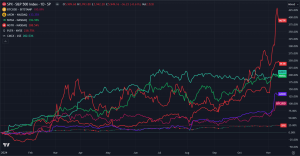China has seized outsized market share in industries from textiles to solar panels, accomplished a lock on rare earth minerals, and threatens to become an export juggernaut in electric vehicles through protectionist industrial policies.
U.S. President Joe Biden has responded with the Chips and Science Act and the Inflation Reduction Act. These policies aim to level the playing field in batteries, EVs, semiconductors and other cutting-edge industries.
European politicians decry these and other U.S. industrial policies as dangerous and the end of the liberal trade order. Progressive business leaders, politicians and intellectuals also rail against threats to the liberal international economic system, They blame populists and nationalists for the situation.
That’s dead wrong. Biden may be even more protectionist than former President Donald Trump. What’s going on, and what the hard data reflects, is a reordering of globalization and trade — not its demise.
Businesses seeking the lowest-cost solutions often create long and complex supply chains that can break easily and then not be quickly repaired. For example, supply chain disruptions and shortages likely contributed half of the current bout of U.S. inflation.
Owing to Russia’s invasion of Ukraine, China’s botched COVID policy and tensions in the Strait of Taiwan, these risks are well-recognized and businesses are behaving rationally. Rather than simply bringing production home, multinationals are diversifying. In some cases, the transition is relatively simple — moving sewing machines or metal fabrication from China to Vietnam or Mexico, or transferring production of iPhones to India.
Also, the scale needed to accomplish the most competitive production in manufacturing may be shrinking thanks to robotics, new materials, 3-D printers and other advanced technology. For example, British startup Arrival is trying to make cost-competitive electric vehicles in micro-factories. Its success would diminish the free-trade imperative for automotive production.
“ Like 1930s dictators, Putin and Xi invested in armies and not enough on economic resilience and social infrastructure. ”
The U.S. and Europe are setting their boundaries. Biden is defending America against China’s economic imperialism. German Chancellor Olaf Scholz sees a shift to a multipolar world. Meanwhile, European Commission President Ursula von der Leyen recognizes Europe’s need for its own Chips Act and IRA.
It’s getting awfully chilly inside the Kremlin and China’s Central Committee.
Autocrats look in the mirror and see flawless philosophers — omnipotent, omnipresent, and omniscient — and then they blunder. Russia into stalemate in Ukraine and China into the jaws of America’s export embargoes on technology with military applications and machinery for advanced chipmaking.
Like 1930s dictators, Russia’s President Vladimir Putin and China’s President Xi Jinping invested in armies and not enough on economic resilience and social infrastructure. A shortage of hospital beds and medicines to confront COVID bear witness to Xi’s obsessions.
Nothing would be available to Russia and China by taking Ukraine and Taiwan that wouldn’t be accessible had they not built armies and navies to fend off threats that don’t exist. Now Putin and Xi must reckon with Germany and Japan rearming.
NATO is strengthening its forces and may add Sweden to its ranks after Finland. Japan, Australia, South Korea — with assistance from the United States, France and the UK — are beefing up Pacific security cooperation.
To complement these efforts, the West needs to build a new trade system — for example, one with the Trans-Pacific Partnership as its hub — to ensure its industrial policies generate mutual benefit and confront the threats to prosperity and democracy that Russia and China now pose.
Peter Morici is an economist and emeritus business professor at the University of Maryland, and a national columnist.
More: America’s most powerful weapon to beat China and Russia in Cold War 2.0 is free trade
This post was originally published on Market Watch






